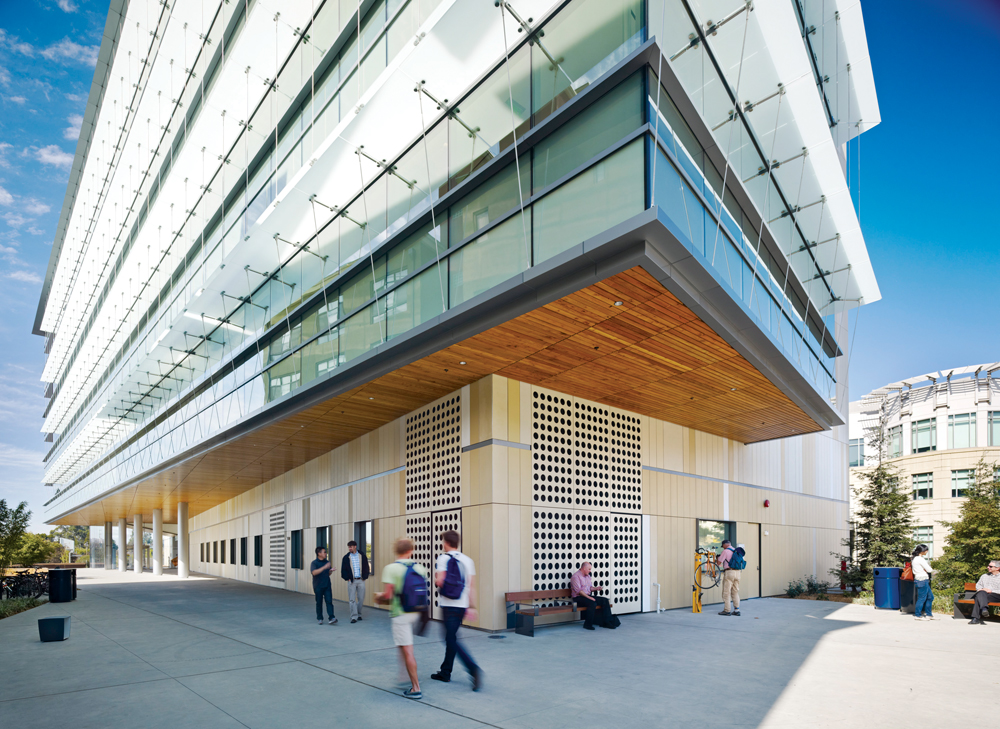After an era of biology-oriented spending—largely driven by Big Pharma and government concerns about bioterrorism—climate change is reshaping priorities in science and technology construction. “Engineering and chemistry funding are going up now, as is energy research, which seems to continue to get federal funding,” says Andy Vazzano, FAIA, LEED AP, Science and Technology Practice Leader at SmithGroupJJR. “Meanwhile, the sequester and budget cuts are having a negative impact on NIH funding for biomedical research.”
The focus on human health hasn’t totally faded, with many research universities still building new labs—especially those that tie research to clinical practice. “Anything that begins with ‘trans’ or ‘inter’ is still a major trend,” says Ryan Abbott, Science and Technology Project Director at Sundt Construction and a BD+C “40 Under 40” honoree (Class of 2012). “Translational, interdisciplinary. Modern science is a team sport.”
TOP S&T SECTOR ARCHITECTURE FIRMS
2012 S+T Revenue ($)1 HDR Architecture $91,252,0002 Perkins+Will $48,373,5683 HOK $38,347,0004 Stantec $33,111,4695 SmithGroupJJR $26,400,0006 Flad Architects $21,480,0007 Payette $18,434,0298 ZGF Architects $16,214,2679 EwingCole $11,000,00010 FKP Architects $10,250,000
TOP S&T SECTOR ENGINEERING FIRMS
2012 S+T Revenue ($)1 Affiliated Engineers $19,824,0002 Middough $13,900,0003 URS Corp. $11,772,1244 Bard, Rao + Athanas Consulting Engineers $10,500,0005 RMF Engineering Design $9,200,0006 Vanderweil Engineers $7,851,9007 Paulus, Sokolowski and Sartor $7,500,0008 WSP USA $5,772,0959 Science Applications International Corp. $3,103,15210 STV $2,937,000
TOP S&T SECTOR CONSTRUCTION FIRMS
2012 S+T Revenue ($)1 Skanska USA $376,717,4742 DPR Construction $298,563,6423 Suffolk Construction $290,560,3074 Manhattan Construction $199,444,0005 Whiting-Turner Contracting Co., The $193,160,4256 JE Dunn Construction $184,799,0517 Clark Group $174,348,8048 Turner Corporation, The $157,490,0009 Structure Tone $143,798,00010 Consigli Construction $74,568,263
Though the purpose-built med school building is the iconic face of S+T, adaptive reuse is getting a second look for advantages in cost and speed. Many clients are also seeking higher levels of green; LEED Platinum, once thought impossible for labs, is no longer unique, and clients are increasingly eyeing net-zero.
In addition, look for public/private partnerships to assume a greater role, even in the rarefied atmosphere of the Ivy League. Harvard, for instance, has rethought its Allston science campus during a recession hiatus. When the site cranks up again next year, the program will include a 36-acre, privately developed “enterprise research campus” for related companies in pharma, biotech, and venture capital.
Read BD+C's full Giants 300 Report
Related Stories
Architects | May 2, 2024
Emerging considerations in inclusive design
Design elements that consider a diverse population of users make lives better. When it comes to wayfinding, some factors will remain consistent—including accessibility and legibility.
K-12 Schools | Apr 30, 2024
Fully electric Oregon elementary school aims for resilience with microgrid design
The River Grove Elementary School in Oregon was designed for net-zero carbon and resiliency to seismic events, storms, and wildfire. The roughly 82,000-sf school in a Portland suburb will feature a microgrid—a small-scale power grid that operates independently from the area’s electric grid.
AEC Tech | Apr 30, 2024
Lack of organizational readiness is biggest hurdle to artificial intelligence adoption
Managers of companies in the industrial sector, including construction, have bought the hype of artificial intelligence (AI) as a transformative technology, but their organizations are not ready to realize its promise, according to research from IFS, a global cloud enterprise software company. An IFS survey of 1,700 senior decision-makers found that 84% of executives anticipate massive organizational benefits from AI.
Codes and Standards | Apr 30, 2024
Updated document details methods of testing fenestration for exterior walls
The Fenestration and Glazing Industry Alliance (FGIA) updated a document serving a recommended practice for determining test methodology for laboratory and field testing of exterior wall systems. The document pertains to products covered by an AAMA standard such as curtain walls, storefronts, window walls, and sloped glazing. AAMA 501-24, Methods of Test for Exterior Walls was last updated in 2015.
MFPRO+ News | Apr 29, 2024
World’s largest 3D printer could create entire neighborhoods
The University of Maine recently unveiled the world’s largest 3D printer said to be able to create entire neighborhoods. The machine is four times larger than a preceding model that was first tested in 2019. The older model was used to create a 600 sf single-family home made of recyclable wood fiber and bio-resin materials.
K-12 Schools | Apr 29, 2024
Tomorrow's classrooms: Designing schools for the digital age
In a world where technology’s rapid pace has reshaped how we live, work, and communicate, it should be no surprise that it’s also changing the PreK-12 education landscape.
Adaptive Reuse | Apr 29, 2024
6 characteristics of a successful adaptive reuse conversion
In the continuous battle against housing shortages and the surplus of vacant buildings, developers are turning their attention to the viability of adaptive reuse for their properties.
AEC Innovators | Apr 26, 2024
National Institute of Building Sciences announces Building Innovation 2024 schedule
The National Institute of Building Sciences is hosting its annual Building Innovation conference, May 22-24 at the Capital Hilton in Washington, D.C. BI2024 brings together everyone who impacts the built environment: government agencies, contractors, the private sector, architects, scientists, and more.
Mass Timber | Apr 25, 2024
Bjarke Ingels Group designs a mass timber cube structure for the University of Kansas
Bjarke Ingels Group (BIG) and executive architect BNIM have unveiled their design for a new mass timber cube structure called the Makers’ KUbe for the University of Kansas School of Architecture & Design. A six-story, 50,000-sf building for learning and collaboration, the light-filled KUbe will house studio and teaching space, 3D-printing and robotic labs, and a ground-level cafe, all organized around a central core.
Sports and Recreational Facilities | Apr 25, 2024
How pools can positively affect communities
Clark Nexsen senior architects Jennifer Heintz and Dorothea Schulz discuss how pools can create jobs, break down barriers, and create opportunities within communities.

















